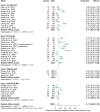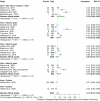Hypogammaglobulinemia and infections in patients with multiple sclerosis treated with anti-CD20 treatments: a systematic review and meta-analysis of 19,139 multiple sclerosis patients
- PMID: 38699050
- PMCID: PMC11063306
- DOI: 10.3389/fneur.2024.1380654
Hypogammaglobulinemia and infections in patients with multiple sclerosis treated with anti-CD20 treatments: a systematic review and meta-analysis of 19,139 multiple sclerosis patients
Abstract
Background: Recent years have seen the emergence of disease-modifying therapies in multiple sclerosis (MS), such as anti-cluster of differentiation 20 (anti-CD20) monoclonal antibodies, aiming to modulate the immune response and effectively manage MS. However, the relationship between anti-CD20 treatments and immunoglobulin G (IgG) levels, particularly the development of hypogammaglobulinemia and subsequent infection risks, remains a subject of scientific interest and variability. We aimed to investigate the intricate connection between anti-CD20 MS treatments, changes in IgG levels, and the associated risk of hypogammaglobulinemia and subsequent infections.
Method: PubMed, Scopus, Embase, Cochrane, and Web of Science databases have been searched for relevant studies. The "R" software utilized to analyze the occurrence of hypogammaglobulinemia, infections and mean differences in IgG levels pre- and post-treatment. The subgrouping analyses were done based on drug type and treatment duration. The assessment of heterogeneity utilized the I2 and chi-squared tests, applying the random effect model.
Results: Thirty-nine articles fulfilled our inclusion criteria and were included in our review which included a total of 20,501 MS patients. The overall prevalence rate of hypogammaglobulinemia was found to be 11% (95% CI: 0.08 to 0.15). Subgroup analysis based on drug type revealed varying prevalence rates, with rituximab showing the highest at 18%. Subgroup analysis based on drug usage duration revealed that the highest proportion of hypogammaglobulinemia occurred in individuals taking the drugs for 1 year or less (19%). The prevalence of infections in MS patients with a focus on different infection types stratified by the MS drug used revealed that pulmonary infections were the most prevalent (9%) followed by urinary tract infections (6%), gastrointestinal infections (2%), and skin and mucous membrane infections (2%). Additionally, a significant decrease in mean IgG levels after treatment compared to before treatment, with a mean difference of 0.57 (95% CI: 0.22 to 0.93).
Conclusion: This study provides a comprehensive analysis of the impact of anti-CD20 drugs on serum IgG levels in MS patients, exploring the prevalence of hypogammaglobulinemia, based on different drug types, treatment durations, and infection patterns. The identified rates and patterns offer a foundation for clinicians to consider in their risk-benefit.
Systematic review registration: https://www.crd.york.ac.uk/prospero/display_record.php?RecordID=518239, CRD42024518239.
Keywords: anti-CD20; hypogammaglobulinemia; infections; meta-analysis; multiple sclerosis.
Copyright © 2024 Elgenidy, Abdelhalim, Al-kurdi, Mohamed, Ghoneim, Fathy, Hassaan, Anan and Alomari.
Conflict of interest statement
The authors declare that the research was conducted in the absence of any commercial or financial relationships that could be construed as a potential conflict of interest.
Figures










References
Publication types
LinkOut - more resources
Full Text Sources

